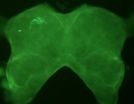INFORMATION:
Study shows Africanized bees continue to spread in California
2015-09-11
(Press-News.org) A study conducted by biologists at UC San Diego has found that the Africanized honey bee--an aggressive hybrid of the European honey bee--is continuing to expand its range northward since its introduction into Southern California in 1994.
The study, published in this week's edition of the journal PLOS ONE, found that more than 60 percent of the foraging honey bees in San Diego County are Africanized and that Africanized bees can now be found as far north as California's delta region.
"Our study shows that the large majority of bees one encounters in San Diego County are Africanized and that most of the bees you encounter are from feral colonies, not managed hives," said Joshua Kohn, a professor of biology at UC San Diego who headed the study.
"The pattern of Africanization we documented in San Diego County and elsewhere in California appears consistent with patterns previously documented in Texas, where Africanized honey bees first appeared in the United States. After the initial wave of hybridization, the remaining bees have a mixture of African and European genes, with the majority of the genome from Africa."
Africanized bees are hybrids of a subspecies from southern Africa that were brought to Brazil to improve honey production, but escaped and spread throughout South America and Central America, arriving in Mexico in 1985 and Texas in 1990. Their aggressive behavior and tendency to swarm victims have led them to be dubbed "killer bees."
Kohn said that while the southern range of the bees has stabilized in Argentina, the northward expansion is still ongoing. He and his graduate student Yoshiaki Kono sought to determine how far and how fast the northward expansion of Africanized bees was occurring in California by examining the genetic markers of 265 honey bees they collected at 91 sites throughout the state.
They found Africanized genetic traits in honey bees as far north as 40 kilometers south of Sacramento in the state's central valley. In the bees they collected in San Diego, they also discovered that more than 60 percent of foraging honey bee workers have Africanized genetic traits, but that African traits are found in only 13 percent of managed or commercial hives.
"Most of the bees you encounter in San Diego are from feral colonies, not managed hives," said Kohn. "Bees from beekeepers are largely European."
The biologists also found that the feral honey bees they collected in San Diego County were smaller than their counterparts in the northern parts of the state.
"One of the ways to tell the two bee types apart is their size," said Kohn. "European bees tend to be larger than Africanized. So bees in San Diego County are smaller than they are further north because further north honey bees are largely European."
Scientists estimate that Africanized bees are capable of expanding their range by as much as 300 to 500 kilometers per year. But because the UC San Diego biologists found Africanized bees only 250 kilometers from their northernmost limit in 2006, they concluded that Africanized bees' expansion rate in California has slowed considerably.
Since Africanized bees have a limited ability to survive cold temperatures, this slower expansion rate could be an indication that they are approaching--or have already reached--their northernmost temperature limits. The biologists said their sampling last spring followed the warmest winter on record for the state and that a continued warming trend, predicted by some climate change models, could further expand the range of Africanized bees.
While the presences of Africanized bees increases the risk of negative interactions with humans, they may provide opportunities for improving the genetic stock of honey bees used in agriculture, said Kohn.
"Feral Africanized bees have replaced European ones everywhere from Brazil to California," he noted. "Part of the reason for this is their increased aggression, but there may be other factors. For instance, Africanized honey bees may be better able to resist certain diseases that afflict honey bee colonies. By dissecting the genomes of Africanized honey bees to find regions responsible for advantageous traits, we may be able to combat recent declines in managed honey bee populations that are so critical for food production."
ELSE PRESS RELEASES FROM THIS DATE:
Neural circuit in the cricket brain detects the rhythm of the right mating call
2015-09-11
Scientists have identified an ingeniously elegant brain circuit consisting of just five nerve cells that allows female crickets to automatically identify the chirps of males from the same species through the rhythmic pulses hidden within the mating call.
The circuit uses a time delay mechanism to match the gaps between pulses in a species-specific chirp - gaps of just few milliseconds. The circuit delays a pulse by the exact between-pulse gap, so that, if it coincides with the next pulse coming in, the same species signal is confirmed.
It's one of the first times ...
Large eyes come at a high cost
2015-09-11
Researchers from Lund University in Sweden have shown that well-developed eyes come at a surprising cost to other organ systems. The study involving Mexican cavefish shows that the visual system can require between 5% and 15% of an animal's total energy budget.
Researchers have long associated the presence of a well-developed brain with major energy consumption. This means that animals that develop advanced nervous systems require environments where this is possible. There has to be good access to nutrients, and every investment in an organ comes at a cost to some other ...
Study supports aggressive treatment of high blood pressure, says ACC president
2015-09-11
WASHINGTON (Sept. 11, 2015) - A statement from American College of Cardiology President Kim Allan Williams Sr., M.D., FACC, regarding the National Institutes of Health stopping the SPRINT trial early after demonstrating the positive benefits of lower blood pressure control targets:
"About 70 million American adults have high blood pressure and only half of them have their condition under control. The preliminary data demonstrates why the cardiovascular community must continue to aggressively fight a condition that leads to stroke, kidney disease and heart problems for ...
Periodontitis and heart disease: Researchers connect the molecular dots
2015-09-11
Washington, DC - September 11, 2015 - Periodontitis is a risk factor for heart disease. Now a team of researchers has shown that a periodontal pathogen causes changes in gene expression that boost inflammation and atherosclerosis in aortic smooth muscle cells. The research is published ahead of print in Infection and Immunity, a journal of the American Society for Microbiology.
The circumstantial evidence that led to this study was ample. The periodontal pathogen, Porphyromonas gingivalis, has also been found in coronary artery plaques of heart attack patients. And in ...
Too many candidates spoil the stew
2015-09-11
This election year has produced 17 Republican presidential candidates, which on its surface may appear to give the party a competitive advantage. Evolution, however, disagrees.
A new study by Michigan State University researcher Arend Hintze and appearing in the current issue of Scientific Reports, says the delicate balance of some, but not too much, competition optimally drives the evolution of decision-making strategies.
"Competition has a unique relationship with our decision-making strategies as humans," said Hintze, an assistant professor at MSU. "Modest competition ...
Nano in food and agriculture: Regulations require collaboration to ensure safety
2015-09-11
An overview of regulatory solutions worldwide on the use of nanotechnology in food and feed production shows a differing approach: only the EU and Switzerland have nano-specific provisions incorporated in existing legislation, whereas other countries count on non-legally binding guidance and standards for industry. Collaboration among countries across the globe is required to share information and ensure protection for people and the environment, according to a JRC co-authored paper.
The paper Regulatory aspects of nanotechnology in the agri/feed/food sector in EU and ...
Insights into obscure transition uncovered by X-rays
2015-09-11
The list of potential mechanisms that underlie an unusual metal-insulator transition has been narrowed by a team of scientists using a combination of X-ray techniques. This transition has ramifications for material design for electronics and sensors.
The transition between being electrically conductive (metallic) at high temperatures and electrically insulating at lower temperatures is known as a metal-insulator transition (MIT). Pinpointing the activation mechanism that allows crystals used in devices such as transistors in electronics and temperature-based sensor control ...
Disney Research demonstrates LEDs that use visible light to talk to each other and internet
2015-09-11
The light that typically floods homes, offices and public buildings could provide something more than illumination. Scientists at Disney Research and ETH Zurich have demonstrated that light could be a medium for light bulbs to communicate - with each other, with objects and with the Internet.
Transmitting signals via light is nothing new; Alexander Graham Bell showed that speech could be conveyed with light in the 1880s, years before speech was first transmitted via radio. The Disney researchers, however, have created networking technology that makes it possible for LED ...
Innovative imaging technique reveals new cellular secrets
2015-09-11
KANSAS CITY, MO -- Cellular mitosis depends in part on small organelles that extend spindles to pull apart chromosome pairs. Before they can perform this and other essential tasks, these tiny cylindrical structures -- known as centrioles in animals and spindle pole bodies (SPBs) in yeast -- must themselves duplicate.
However, much about this nanoscale process has remained veiled by the limits of current microscopy. Optical approaches cannot resolve objects below certain wavelength limits, while non-optical approaches like electron microscopy (EM) can only study nonliving ...
Predicting tornadoes months or even seasons in advance
2015-09-11
What if tornado activity could be forecasted months, even seasons in advance? Thanks to a new model developed at the University of Toronto Scarborough, that ability could soon become a reality.
"The aim is to predict ahead to the following year or subsequent years about whether we'll get above or below average tornado activity in a given area," says Vincent Cheng, a postdoctoral fellow in UTSC's Ecological Modelling Lab.
The model, developed by Cheng, Professor George Arhonditsis and Professor Bill Gough in UTSC's Climate Lab along with colleagues at Environment Canada, ...


